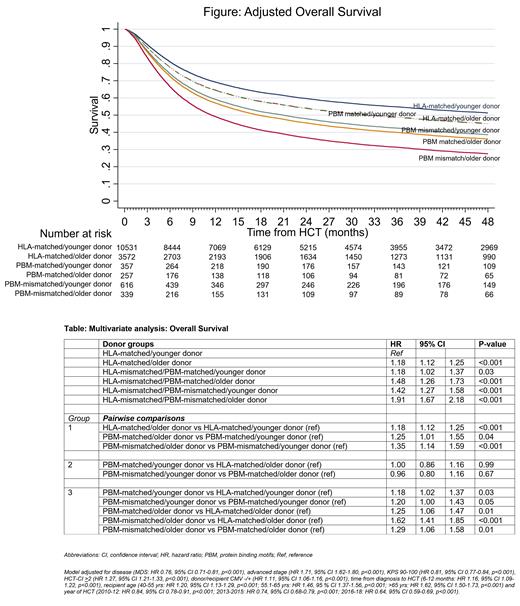Background: HLA-mismatched unrelated donors (MMUDs) can be either matched or mismatched at protein binding motifs (PBM), while all HLA-matched donors are PBM-matched. A MMUD who is class I PBM-matched in the graft-vs-host (GVH) direction is preferred over a PBM-mismatched donor [ JCO.2023;41(13):2416]. As donor age is also an important prognostic factor, we hypothesized that using a younger donor could compensate for the inferior overall survival (OS) associated with PBM-mismatches. Specifically, we tested if OS after transplantation with HLA-mismatched/PBM-matched/younger donors is similar to that with HLA-matched/older donors, and if OS is similar with HLA-mismatched/PBM-mismatched/younger donors as with HLA-mismatched/PBM-matched/older donors.
Methods: We analyzed the outcomes of patients with acute leukemia or myelodysplastic neoplasms who underwent HLA-matched or single class I MMUD HCT with a calcineurin inhibitor (CNI) for GVHD prophylaxis using a publicly available Center for International Blood and Marrow Transplant Research dataset. HLA class I MMUDs were categorized as “PBM-mismatched” if there was any GVH mismatch for the PBM, or “PBM-matched” if there was PBM-matching or only host-versus-graft mismatching. Donor age was dichotomized as “older” (> 35 years) or “younger” (< 35 years).
Six groups were compared: HLA-matched/younger donor (n=10,531), HLA-matched/older donor (n=3572), PBM-matched/younger donor (n=357), PBM-matched/older donor (n=257), PBM-mismatched/younger donor (n=616), and PBM-mismatched/older donor (n=339). The primary outcome of interest was OS.
Results: Median patient age was 50.3-56.2 years. Acute myeloid leukemia was the most common diagnosis in all groups (53-60%), most had early/intermediate disease (64-70%), most received myeloablative conditioning (60-69%) and peripheral blood (PB) graft (76-81%). A minority (18-23%) had T-cell epitope -DPB1 non-permissive GVH mismatched. All patients received CNI-based prophylaxis, without post-transplant cyclophosphamide (PTCy). Median follow-up among survivors was 48-61 months.
In multivariate analysis, transplantation from HLA-matched/younger donors was associated with superior OS relative to any other group [ Figure]. The notable findings of pairwise comparisons were three-fold. First, donor age significantly impacts OS in both HLA-matched and HLA-mismatched groups, but the negative impact of older donors relative to younger donors increases with increased mismatching for the PBM (18%, 25% and 35% increased mortality in older compared to younger donors within HLA-matched, PBM-matched and PBM-mismatched groups, respectively) [ Table, pairwise comparison group 1]. Secondly, younger donors appear to negate the detrimental effect of PBM-mismatching [comparison group 2]. Specifically, the PBM-matched/younger donor group had similar OS as the HLA-matched/older donor group and the PBM-mismatched/younger donor group had similar OS as the PBM-matched/older donor group. Thirdly, HLA/PBM-matching is important within the younger and the older donor groups [comparison group 3]; however, the impact of PBM-mismatching was higher with older donors (25% and 62% increased risk of mortality with PBM-matched and PBM-mismatched, respectively than HLA-matched) than with younger donors (18% and 42% increased risk of mortality with PBM-matched and PBM-mismatched than HLA-matched).
Conclusion: Older unrelated donor age and PBM-mismatching confer similarly adverse effects on OS after transplantation with CNI prophylaxis and the impacts are additive. The preferred donor is HLA-matched, followed by HLA-mismatched/PBM-matched, and HLA-mismatched/PBM-mismatched. Transplantation from younger donors with inferior matching led to comparable outcomes as the older donors with better matching - a finding which may widen the “acceptable” donor pool. The best OS is observed with HLA-matched/younger donors and the worst with PBM-mismatched/older donors. Whether the use of PTCy modifies the impact of donor age and/or HLA/PBM-mismatching needs investigation.
Disclosures
Mehta:Incyte: Research Funding; CSL Behring: Research Funding; Kadmon: Research Funding. Lee:Novartis: Other: Steering Committee member; Janssen: Other: Study medication provider; Amgen, AstraZeneca, Incyte, Kadmon, Pfizer, Syndax: Research Funding; Equillium, Kadmon, Mallinckrodt: Consultancy.


This feature is available to Subscribers Only
Sign In or Create an Account Close Modal